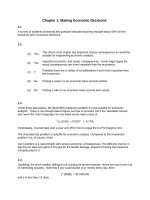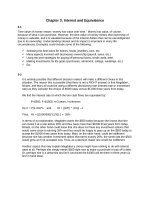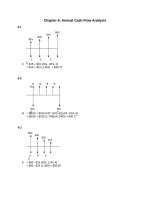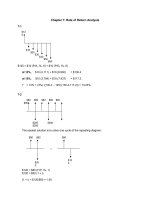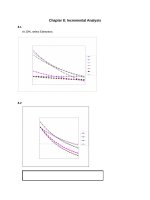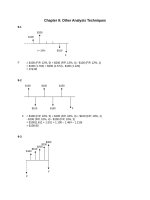Solution manual engineering economic analysis 9th edition ch07a
Bạn đang xem bản rút gọn của tài liệu. Xem và tải ngay bản đầy đủ của tài liệu tại đây (98.54 KB, 20 trang )
Appendix 7A: Difficulties Solving for An Interest Rate
7A-1
Year
0
1-9
10
11-19
Cash Flow
+$4,000
+$4,000
-$71,000
+$4,000
There are 2 sign changes in the cash flow indicating there may be 2, 1, or zero positive interest
rates.
At i = 0%
At i = ∞%
NPW= +$5,000
NPW =+$4,000
This suggests that the NPW plot may look like one of the following:
NPW
Figure A
$5,000
0
i
∞
NPW
$5,000
Figure B
0
i
∞
After making a number of calculations, one is forced to conclude that Figure B is the general
form of the NPW plot, and there is no positive interest rate for the cash flow.
There is external investment until the end of the tenth year. If an external interest rate (we
will call it e* in Chapter 18) is selected, we can proceed to solve for the interest rate i for the
investment phase of the problem.
For external interest rate = 6%
Future worth of $4,000 a year for 10 years (11 payments)
= $4,000 (F/A, 6%, 11) = $4,000 (14.972) = $59,888
At year 10 we have +$59,888 -$75,000 = -$15,112
The altered cash flow becomes:
Year
Cash Flow
0
0
1-9
0
10
-$15,112
11-19
+$4,000
At the beginning of year 10:
PW of Cost = PW of Benefits
$15,112
= $4,000 (P/A, i%, 9)
(P/A, i%, 9)
= $15,112/$4,000
= 3.78
By linear interpolation from interest tables, i = 22.1%.
The internal interest rate is sensitive to the selected external interest rate:
For external
Computed internal
Interest rate
Interest rate
0%
3.1%
6%
22.1%
8%
45.9%
7A-2
The problem statement may be translated into a cash flow table:
Year
0
1
2
3
4
Cash Flow
+$80,000
-$85,000
-$70,000
0
+$80,000
There are two sign changes in the cash flow indicating there may be as many as two
positive rates of return.
To search for positive rates of return compute the NPW for the cash flow at several interest
rates. This is done on the next page by using single payment present worth factors to
compute the PW for each item in the cash flow. Then, their algebraic sum represents NPW
at the stated interest rate.
Year
Cash Flow
PW at 0%
PW at 8%
PW at 9%
0
1
2
3
4
+$80,000
-$85,000
-$70,000
0
+$80,000
+$80,000
-$85,000
-$70,000
0
+$80,000
+$5,000
+$80,000
-$78,700
-$60,010
0
+$58,800
+$90
+$80,000
-$77,980
-$58,920
0
+$56,670
-$230
0%
10%
PW at
25%
+$80,000
-$68,000
-$44,800
0
+$32,770
-$30
PW at
30%
+$80,000
-$65,380
-$41,420
0
+$28,010
+$1,210
+$5,000
20%
30%
i
-$2,000
The plow of NPW vs. i shows two positive interest rates: i ≈ 8.2% and i ≈ 25%
Using an external interest rate of 6%, the Year 0 cash flow is invested and accumulates to +
$80,000 (1.06) = $84,800 at the end of Year 1. The revised cash flow becomes:
Year
0
1
2
3
4
Cash Flow
0
-$200
-$70,000
0
+$80,000
With only one sign change we know there no longer is more than one positive interest rate.
PW of Benefit = PW of Cost, or
PW(Benefit) – PW(Cost) = 0
$80,000 (P/F, i%, 4) - $200 (P/F, i%, 1) - $70,000 (P/F, i%, 2) = 0
Try i = 7%
80,000 (0.7629) - $200 (0.9346) - $70,000 (0.8734) = -$293
Try i = 6%
$80,000 (0.7921) - $200 (0.9434) - $70,000 (0.8900) = +$879
By interpolation, i = 6.75%.
7A-3
(a)
Quarter
0
1
2
3
4
Sum
Quarterly
Cash Flow
-$75
+$75
-$50
+$50
+$125
PW at
0%
-$75
+$75
-$50
+$50
+$125
+$125
PW at
20%
-$75.0
+$62.5
-$34.7
+$28.9
+$60.3
+$42.0
PW at
40%
-$75.0
+$53.6
-$25.5
+$18.2
+$32.5
+$3.8
PW at
45%
-$75.0
+$51.7
-$23.8
+$16.4
+$28.3
-$2.4
By interpolation, i ≈ 43% per quarter. The nominal rate of return = 4 (43%) = 172% per
year.
(b)
Quarter
0
1
2
3
4
Quarterly Cash Flow
-$75
+$75
-$50
+$50
+$125
Transformed Cash Flow
-$75
+$26.46
0
+$50
+$125
Let X = amount required at end of quarter 1 to produce $50 at the end of 2 quarters:
X (1.03) = $50
X = $50/1.03 = $48.54
Solve the Transformed Cash Flow for the rate of return:
Quarter
0
1
2
3
4
Sum
Transformed
Cash Flow
-$75
+$26.46
0
+$50
+$125
PW at 35%
PW at 40%
-$75.00
+$19.60
0
+$20.32
+$37.64
+$2.56
-$75.00
+$18.90
0
+$18.22
+$32.54
-$5.34
Rate of return = 35% + 5% (2.56/(2.56 – (-5.34)))
= 36.6% per quarter
Nominal annual rate of return = 36.6% x 4 = 146%
NOTE:
(c)
Although there are three sign changes in the cash flow, the accumulated
cash flow sign test, (described in Chapter 18) indicates there is only a single
positive rate of return for the untransformed cash flow. It is 43%.
In part (a) the required external investment in Quarter 1, for return in Quarter 2, is
assumed to be at the internal rate of return (which we found is 43% per quarter).
In part (b) the required external investment is at 3% per quarter.
The “correct” answer is the one for the computation whose assumptions more closely
fit the actual problem. Even though there is only one rate of return, there still exists the
required external investment in Quarter 1 for Quarter 2. On this basis the Part (b)
solution appears to have more realistic assumptions than Part (a).
7A-4
Year
0
1
2
3
Sum
Cash Flow
-$500
+$2,000
-$1,200
-$300
0
There are two sign changes in the cash flow indicating as many as two positive rates of
return. The required disbursement in Year 2 & 3 indicate that money must be accumulated
in an external investment to provide the necessary Year 2 & 3 disbursements.
Before proceeding, we will check for multiple rates of return. This, of course, is not
necessary here.
Since the algebraic sum of the cash flow = $0, we know that NPW at 0% = 0, and 0% is a
rate of return for the cash flow.
Looking for the other (possible) rate of return:
Year
Cash Flow
0
1
2
3
-$500
+$2,000
-$1,200
-$300
NPW =
PW at
5%
-$500
+$1,905
-$1,088
-$259
+$58
PW at
50%
-$500
+$1,333
-$533
-$89
+$211
PW at
200%
-$500
+$667
-$133
-$11
+$23
PW at
219%
-$500
+$627
-$118
-$9
0
PW at
250%
-$500
+$571
-$98
-$7
-$34
PW at
∞%
-$500
$0
$0
$0
-$500
+$500
-$500
0%
219%
i
Solution using an external interest rate e* = 6%.
How much of the +$2,000 at Year 1 must be set aside in an external investment at 6% to
provide for the Year 2 and Year 3 disbursements?
Amount to set aside = $1,200 (P/F, 6%, 1) + $300 (P/F, 6%, 2)
= $1,200 (0.94.4) + $300 (0.8900)
= $1,399.08
The altered cash flow becomes:
Year
0
1
2
3
Cash Flow
-$500
+$2,000 -$1,399.08 = +
$600.92
0
0
Solve the altered cash flow for the unknown i:
$500 = $600.92 (P/F, i%, 1)
(P/F, i%, 1) = $500/$600.92
= 0.8321
From tables: 20.2%
7A-5
Year
Cash Flow
0
1
2
3
-$500
+$2,000
-$1,200
-$300
$200(1.06)
= +$212
Altered
Cash Flow
-$500
0
-$288
+$1,200
+$412
PW at
18%
PW at 20%
+$23
-$6
PW at
12%
-$100
0
-$150
+$256
PW at
15%
-$100
0
-$142
+$237
The rate of return is 18% + (2%) (23/(23 + 6)) = 19.6%
7A-6
Year
Cash Flow
0
1
2
3
NPW=
-$100
+$360
-$570
+$360
+$50
PW at
20%
-$100
+$300
-$396
+$208
+$12
PW at
35%
-$100
+$267
-$313
+$146
0
PW at
50%
-$100
+$240
-$253
+$107
-$6
There is a single positive rate of return at 35%.
Year
Cash Flow
0
1
2
3
-$100
+$360
-$570
+$360
$360(1.06)
= +$382
Altered
Cash Flow
-$100
0
-$188
+$360
+$72
+$6
-$5
Rate of return ≈ 13.6%.
For further computations, see the solution to Problem 18-4.
7A-7
Some money flowing out of the cash flow in Year 2 will be required for the Year 3 investment
of $100. At 10% external interest, $90.91 at Year 2 becomes the required $100 at Year 3.
Year
Cash Flow
0
1
2
3
4
5
-$110
-$500
+$300
-$100
+$400
+$500
-$90.91(1.10)
= +$100
Transformed
Cash Flow
-$110
-$500
+$209.09
0
+$400
+$500
NPW at
20%
-$110.00
-$416.65
+$145.19
0
+$192.92
+$200.95
+$12.41
NPW at
25%
-$110.00
-$400
+$133.82
0
+$163.84
+$163.85
-$48.49
The rate of return on the transformed cash flow is 21%. (This is only slightly different from
the 21.4% rate of return on the original cash flow because the external investment is small
and of short duration.)
7A-8
Year
Cash Flow
0
1
2
3
4
5
-$50.0
+$20.0
-$40.0
+$36.8
+$36.8
+$36.8
$20(1.10)
= +$22
Transformed
Cash Flow
-$50.0
0
-$18.0
+$36.8
+$36.8
+$36.8
PW at 15%
-$50.0
0
-$13.6
+$24.2
+$21.0
+$18.3
-$0.1
From the computations we see that the rate of return on the internal investment is 15%.
7A-9
Year
Cash Flow
0
1
2
3
4
-$15,000
+$10,000
+$6,000
-$8,000
+$4,000
X 1.12 = +$6,720
Y (1.12)2 = +$1,280
Transformed
Cash Flow
-$15,000
+$8,980
0
0
+$4,000
5
6
Year
0
1
2
3
4
5
6
Sum
+$4,000
+$4,000
Y = $1,020
Transformed
Cash Flow
-$15,000
+$8,980
0
0
+$4,000
+$4,000
+$4,000
+$4,000
+$4,000
PW at 10%
PW at 12%
-$15,000
+$8,164
0
0
+$2,732
+$2,484
+$2,258
+$638
-$15,000
+$8,018
0
0
+$2,542
+$2,270
+$2,026
-$144
Rate of Return = 10% + (2%) (638/(638+144)) = 11.6%
7A-10
The compound interest tables are for positive interest rates and are not useful here. (Tables
could be produced, of course, for negative values.)
PW of Cost = PW of Benefits
$50 = $20 (1 + i)-1 + $20 (1 + i)-2
let x = (1+ i)-1 thus, $50 = $20x + $20x2 or x2 + x – 2.50 = 0
x = - 1 + (12 – 4(-2.50))1/2
2
Solving for i:
x = (1 + i)-1 = +1.159
x = (1 + i)-1 = -2.158
= - 1+ (11)1/2
= +1.159, -2.158
2
1 + i = 1/1.159 = 0.863
1 + i = 1/-2.158 = -0.463
i = -0.137 = -13.7%
i = -1.463 = -146%
7A-11
Year
Cash Flow
0
1
2
3
4
5
6
7
0
0
-$20
0
-$10
+$20
-$10
+$100
X (1.15) = +$10
X = $10/1.15 = $8.7
Transformed
Cash Flow
0
0
-$20
0
-$10
+$11.3
0
+$100
Year
0
1
2
3
4
5
6
7
Transformed
Cash Flow
0
0
-$20
0
-$10
+$11.3
0
+$100
PW at 35%
PW at 40%
0
0
-$11.0
0
-$3.0
+$2.5
0
+$12.2
0
0
-$10.2
0
-$2.6
+$2.1
0
+$9.5
Rate of return = 35% + 5% (0.7/(0.7+1.2))
= 36.8%
7A-12
Year
Cash Flow
0
1
2
3
4
5
-$800
+$500
+$500
-$300
+$400
+$275
X (1.10) = +$300
X = $300/1.10 = $272.73
Transformed
Cash Flow
-$800
+$500
+$227.27
0
+$400
+$275
PW at 25%
-$800
+$400
+$145.5
0
+$163.8
+$90.1
-0.6
From the Present Worth computation it is clear that the rate of return is very close to 25%
(Calculator solution says 24.96%).
7A-13
Year
0
1
2
Cash
flow
-100
240
-143
2 sign changes => 2 roots possible
I
0%
10%
20%
30%
40%
PW
-3
0
1
0
-2
=$B$2+NPV(D2,$B$3:$B$4)
10.00%
30.00%
root
root
6%
12%
8.8%
external financing rate
external investing rate
MIRR
value is less than external investing rate => not attractive
7A-14
Cash
Year
flow
0
-610
1
200
2
200
3
200
4
200
5
200
6
200
7
200
8
200
9
200
10
-1300
2 sign changes => 2 roots possible
I
0%
5%
10%
15%
17%
19%
20%
25%
PW
-110
13
41
23
10
-6
-14
-57
=$B$2+NPV(D2,$B$3:$B$12)
4.07%
18.29%
root
root
6%
12%
9.5%
external financing rate
external investing rate
MIRR
value is less than external investing rate => not attractive
7A-15
Year
0
1
2
3
Cash
flow
-500
800
170
-550
i
0%
10%
20%
30%
40%
50%
60%
PW
-80
-45
-34
-34
-42
-54
-68
=$B$2+NPV(D2,$B$3:$B$5)
#NUM! root
#NUM! root
No roots exist
2 sign changes => 2 roots possible
6%
12%
7.5%
external financing rate
external investing rate
MIRR
value is less than external investing rate => not attractive
7A-16
Year
0
1
2
3
Cash
flow
-100
360
-428
168
I
0%
10%
20%
30%
40%
50%
60%
3 sign changes => 3 roots possible
6%
12%
8.8%
PW
0.00 =$B$2+NPV(D2,$B$3:$B$5)
-0.23
0.00
0.14
0.00
0.00% root
-0.44
20.00% root
-1.17
40.00% root
All PW values = 0 given significant digits of cash
flows
external financing rate
external investing rate
MIRR
value is less than external investing rate => not attractive
7A-17
Year
0
1
2
3
4
5
6
Cash
flow
-1200
358
358
358
358
358
-394
2 sign changes => 2 roots possible
i
-45%
-40%
-30%
-20%
-10%
0%
10%
20%
PW
-422
970
1358
970
541
196
-65
-261
=$B$2+NPV(D2,$B$3:$B$8)
7.22%
-43.96%
root
root
6%
12%
9.5%
external financing rate
external investing rate
MIRR
value is less than external investing rate => not attractive
7A-18
Cash
Year
flow
0
-3570
1
1000
2
1000
3
1000
4
-3170
5
1500
6
1500
7
1500
8
1500
3 sign changes => 3 roots possible
i
0%
5%
10%
15%
20%
PW
2260
921
-1
-651
-1120
=$B$2+NPV(D2,$B$3:$B$10)
10.00% IRR
unique IRR
7A-19
800
down payment
55
40
2500
monthly payment
# payment
final receipt
-0.75%
-8.62%
1 sign change => 1 root
possible
IRR monthly
=RATE(A3,-A2,-A1,A4)
effective annual rate
=(1+A6)^12-1
7A-20
Cash
Year
flow
0
-850
1
600
2
200
3
200
4
200
5
200
6
200
7
200
8
200
9
200
10
-1800
2 sign changes => 2 roots possible
6%
12%
9.1%
i
0%
5%
10%
15%
17%
19%
20%
25%
PW
-450
-153
-29
7
8
3
-1
-31
=$B$2+NPV(D2,$B$3:$B$12)
12.99%
19.72%
root
root
external financing rate
external investing rate
MIRR
value is less than external investing rate => not attractive
7A-21
Year
0
1
2
3
4
5
Cash
flow
-16000
-8000
11000
13000
-7000
8950
i
0%
5%
10%
15%
20%
PW
1950
-1158
-3639
-5644
-7284
i
PW
=$B$2+NPV(D2,$B$3:$B$7)
3.00% IRR
unique IRR
3 sign changes => 3 roots possible
7A-22
Cash
Year
flow
0
-200
1
100
2
100
3
100
4
-300
5
100
6
200
7
200
8
-124.5
4 sign changes => 4 roots possible
0%
5%
10%
15%
20%
25%
176
111
63
27
0
-21
=$B$2+NPV(D2,$B$3:$B$10)
20.00% IRR
unique IRR
7A-23
Cash
Year
flow
0
-210000
1
88000
2
68000
3
62000
4
-31000
5
30000
6
55000
7
65000
3 sign changes => 3 roots possible
i
0%
5%
10%
15%
20%
PW
127000
74284
34635
4110
-19899
=$B$2+NPV(D2,$B$3:$B$9)
15.78% IRR
unique IRR
7A-24
Cash
Year
flow
0
-103000
1
102700
2
-87000
3
94500
4
-8300
5
38500
5 sign changes => 3 roots possible
i
0%
10%
20%
30%
40%
PW
37400
7699
-11676
-25003
-34594
=$B$2+NPV(D2,$B$3:$B$7)
13.51% IRR
unique IRR
7A-25
Year
0
1
2
Cash
flow
-200
400
-100
i
0%
20%
40%
60%
80%
100%
PW
100
64
35
11
-9
-25
=$B$2+NPV(D2,$B$3:$B$4)
70.71% IRR
unique IRR
2 sign changes => 2 roots possible
6%
12%
24.5%
external financing rate
external investing rate
MIRR
value is more than external investing rate => attractive
7A-26
5
6
7
8
9
0
6,648
0
6,648
0
6,648
0
6,648
0
6,648
138,00
10
36648
0 101,352
IRR
8.0%
11.0%
19.2%
2 sign changes => 2 roots possible
6%
12%
5.1%
6648
6648
6648
6648
6648
50%
60%
70%
1193
-3
-1086
60.0%
root
external financing rate
external investing rate
MIRR for
A-B
value is less than external investing rate => not attractive
7A-27
Cash
Year
flow
0
-1000
1
60
2
60
3
-340
4
0
5
1740
3 sign changes => 3 roots possible
i
0%
5%
10%
15%
20%
PW
520
181
-71
-261
-406
=$B$2+NPV(D2,$B$3:$B$7)
8.44% IRR
unique IRR
